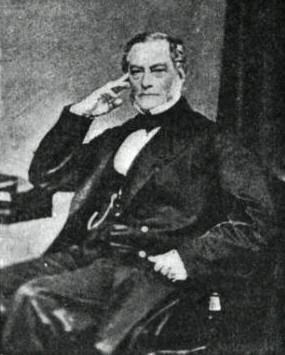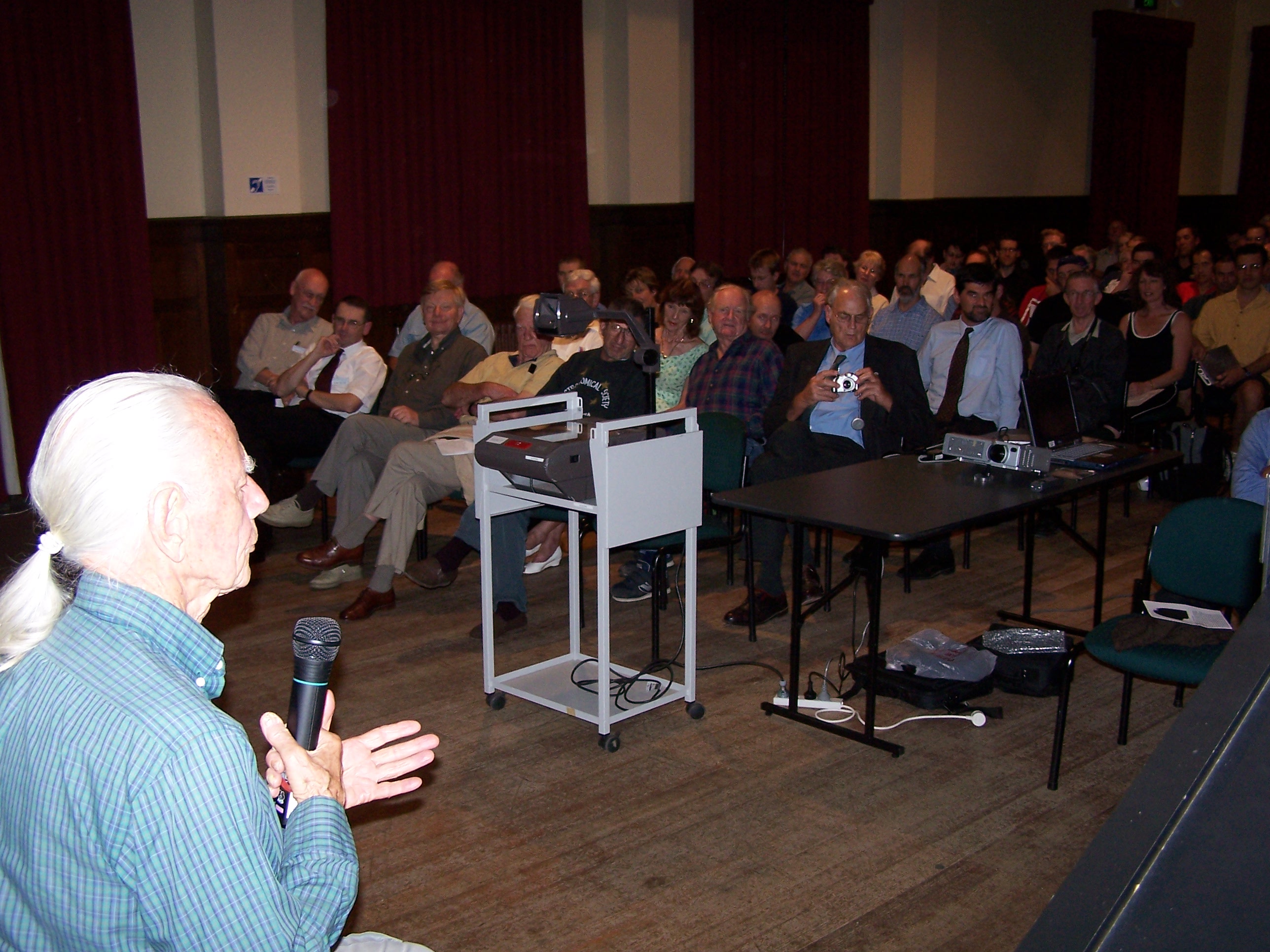|
Great Melbourne Telescope
The Great Melbourne Telescope was built by Thomas Grubb in Dublin, Ireland in 1868, and installed at the Melbourne Observatory in Melbourne, Australia in 1869. In 1945 that Observatory closed and the telescope was sold and moved to the Mount Stromlo Observatory near Canberra. It was rebuilt in the late 1950s. In 2003 the telescope, still in use as an observatory, was severely damaged in a bushfire. About 70% of the components were salvageable; a project to restore the telescope to working condition started in 2013. With a 48 inch (1.2 metre) diameter primary mirror, it was one of the largest telescopes of the late 19th century. This is a significant size even into the 21st century, although the lower reflecting ability of speculum metal mirrors (about 2/3 reflected) makes them inferior to later metal-on-glass designs or large refractors. This was significantly larger than the largest refractors of the period such as the Lick telescope and Yerkes, although those were both in the n ... [...More Info...] [...Related Items...] OR: [Wikipedia] [Google] [Baidu] |
Thomas Grubb
Thomas Grubb (4 August 1800 – 19 September 1878) was an Irish optician and founder of the Grubb Telescope Company. He was born near Portlaw, County Waterford, Ireland, the son of William Grubb Junior, a prosperous Quaker farmer and his second wife, Eleanor Fayle. Thomas started out in 1830 in Dublin as a metal billiard-table manufacturer. He diversified into making telescopes and erected a public observatory near his factory at 1 Upper Charlemont Street, Portobello, Dublin. As makers of some of the largest and best-known telescopes of the Victorian era, the company was at the forefront of optical and mechanical engineering. His innovations for large telescopes included clock-driven polar mounts, whiffletree mirror mounting cells and Cassegrain reflector optics. Grubb helped build the famous telescope for William Parsons, 3rd Earl of Rosse, at Parsonstown (now known as Birr), County Offaly, Ireland. One of his earliest instruments - the telescope for Markree Observatory ... [...More Info...] [...Related Items...] OR: [Wikipedia] [Google] [Baidu] |
John Herschel
Sir John Frederick William Herschel, 1st Baronet (; 7 March 1792 – 11 May 1871) was an English polymath active as a mathematician, astronomer, chemist, inventor, experimental photographer who invented the blueprint and did botanical work. Herschel originated the use of the Julian day system in astronomy. He named seven moons of Saturn and four moons of Uranus – the seventh planet, discovered by his father Sir William Herschel. He made many contributions to the science of photography, and investigated colour blindness and the chemical power of ultraviolet rays. His ''Preliminary Discourse'' (1831), which advocated an inductive approach to scientific experiment and theory-building, was an important contribution to the philosophy of science. Early life and work on astronomy Herschel was born in Slough, Buckinghamshire, the son of Mary Baldwin and astronomer William Herschel. He was the nephew of astronomer Caroline Herschel. He studied shortly at Eton College an ... [...More Info...] [...Related Items...] OR: [Wikipedia] [Google] [Baidu] |
SkyMapper
SkyMapper is a fully automated 1.35 m (4.4 ft) wide-angle optical telescope at Siding Spring Observatory in northern New South Wales, Australia. It is one of the telescopes of the Research School of Astronomy and Astrophysics of the Australian National University (ANU). The telescope has a compact modified Cassegrain design with a large 0.69 m secondary mirror, which gives it a very wide field of view: its single, dedicated instrument, a 268-million pixel imaging camera, can photograph 5.7 square degrees of sky. The camera has six light filters which span from ultraviolet to near infrared wavelengths. The SkyMapper telescope was built to carry out the Southern Sky Survey, which will image the entire southern sky several times over in SkyMapper's six spectral filters over the course of five years. This survey will be analogous to the Sloan Digital Sky Survey of the Northern hemisphere sky. It has several enhancements, including temporal coverage, more precise measu ... [...More Info...] [...Related Items...] OR: [Wikipedia] [Google] [Baidu] |
Copland Foundation '', a 1997 movie starring Sylvester Stallone, Robert De Niro and Harvey Keitel
{{disambiguation ...
Copland may refer to: * Copland (crater), on Mercury * Copland (operating system) * Copland (surname) * Copland River in New Zealand * 4532 Copland, an asteroid named after Aaron Copland * Aaron Copland, American composer See also * Copeland (other) * ''Cop Land ''Cop Land'' is a 1997 American neo-noir crime drama film written and directed by James Mangold. It stars an ensemble cast that includes Sylvester Stallone, Harvey Keitel, Ray Liotta, and Robert De Niro, with Peter Berg, Janeane Garofalo, Robert ... [...More Info...] [...Related Items...] OR: [Wikipedia] [Google] [Baidu] |
Royal Botanic Gardens, Melbourne
Royal Botanic Gardens Victoria are botanic gardens across two sites–Melbourne and Cranbourne. Melbourne Gardens was founded in 1846 when land was reserved on the south side of the Yarra River for a new botanic garden. It extends across that slope to the river with trees, garden beds, lakes and lawns. It displays almost 50,000 individual plants representing 8,500 different species. These are displayed in 30 living plant collections. Cranbourne Gardens was established in 1970 when land was acquired by the Gardens on Melbourne's south-eastern urban fringe for the purpose of establishing a garden dedicated to Australian plants. A generally wild site that is significant for biodiversity conservation, it opened to the public in 1989. On the site, visitors can explore native bushland, heathlands, wetlands and woodlands. One of the features of Cranbourne is the Australian Garden, which celebrates Australian landscapes and flora through the display of approximately 170,000 plan ... [...More Info...] [...Related Items...] OR: [Wikipedia] [Google] [Baidu] |
Astronomical Society Of Victoria
The Astronomical Society of Victoria (ASV) is an amateur astronomy club in the state of Victoria, Australia. It was founded in 1922, making it one of the oldest such clubs in the country, and with some 1500 members it claims to be one of the largest amateur astronomy organisations in the southern hemisphere. Membership is open to all with an interest in astronomy, and the society caters for people with a wide range of ages, backgrounds, abilities and interests. The society has sections dedicated to providing support for members interested in specific aspects of astronomy, including astro-photography, comets, radio astronomy, solar observing, variable stars, and deep sky observing. It owns a suburban property which is used as the Lodge and Observatory / workshop, and it also runs the Leon Mow () Dark Sky Site, located north of Melbourne. Its major project is the restoration of the Great Melbourne Telescope. Structure and Purpose The ASV is registered under the Associations In ... [...More Info...] [...Related Items...] OR: [Wikipedia] [Google] [Baidu] |
Museum Victoria
Museums Victoria is an organisation which operates three major state-owned museums in Melbourne, Victoria: the Melbourne Museum, the Immigration Museum and Scienceworks Museum. It also manages the Royal Exhibition Building and a storage facility in Melbourne's City of Moreland. History The museum traces its history back to the establishment of the "Museum of Natural and Economic Geology" by the Government of Victoria, William Blandowski and others in 1854. The Library, Museums and National Gallery Act 1869 incorporated the Museums with the Public Library and the National Gallery of Victoria; but this administrative connection was severed in 1944 when the Public Library, National Gallery and Museums Act came into force, and they became four separate institutions once again. Museums Victoria was founded in its current form under the Australian Museums Act (1983). Currently, Museums Victoria's State Collections holds over 17 million items, including objects relating to In ... [...More Info...] [...Related Items...] OR: [Wikipedia] [Google] [Baidu] |
2003 Canberra Bushfires
The 2003 Canberra bushfires caused severe damage to the suburbs and outer areas of Canberra, the capital city of Australia, during 18–22 January 2003. Almost 70% of the Australian Capital Territory's (ACT) pastures, pine plantations, and nature parks were severely damaged, and most of the Mount Stromlo Observatory was destroyed. After burning for a week around the edges of the ACT, the fires entered the suburbs of Canberra on 18 January 2003. Over the next ten hours, four people died, over 490 were injured, and 470 homes were destroyed or severely damaged, requiring a significant relief and reconstruction effort. Buildup to the event On 8 January 2003, lightning strikes started four fires in New South Wales, over the border but in close proximity to Canberra. Despite their proximity and very small initial sizes, low intensity, and low rate of spread, these fires were not extinguished or contained by New South Wales emergency services personnel. Subsequent inquiries into t ... [...More Info...] [...Related Items...] OR: [Wikipedia] [Google] [Baidu] |
MACHO
Machismo (; ; ; ) is the sense of being " manly" and self-reliant, a concept associated with "a strong sense of masculine pride: an exaggerated masculinity". Machismo is a term originating in the early 1930s and 1940s best defined as having pride in one’s masculinity. It is associated with "a man's responsibility to provide for, protect, and defend his family". Machismo is strongly and consistently associated with dominance, aggression, exhibition, and nurturance. The correlation to machismo is found to be deeply rooted in family dynamics and culture. The word has a long history both in Spain and Portugal, including the Spanish and Portuguese languages. in Portuguese and Spanish is a strictly masculine term, derived from from the Latin ''mascŭlus'', which means "male". It was originally associated with the ideal societal role men were expected to play in their communities, most particularly Iberian language-speaking societies and countries. In addition, due to Mexico ... [...More Info...] [...Related Items...] OR: [Wikipedia] [Google] [Baidu] |
Charge-coupled Device
A charge-coupled device (CCD) is an integrated circuit containing an array of linked, or coupled, capacitors. Under the control of an external circuit, each capacitor can transfer its electric charge to a neighboring capacitor. CCD sensors are a major technology used in digital imaging. In a CCD image sensor, pixels are represented by p-doped metal–oxide–semiconductor (MOS) capacitors. These MOS capacitors, the basic building blocks of a CCD, are biased above the threshold for inversion when image acquisition begins, allowing the conversion of incoming photons into electron charges at the semiconductor-oxide interface; the CCD is then used to read out these charges. Although CCDs are not the only technology to allow for light detection, CCD image sensors are widely used in professional, medical, and scientific applications where high-quality image data are required. In applications with less exacting quality demands, such as consumer and professional digital cameras, act ... [...More Info...] [...Related Items...] OR: [Wikipedia] [Google] [Baidu] |
Pyrex
Pyrex (trademarked as ''PYREX'' and ''pyrex'') is a brand introduced by Corning Inc. in 1915 for a line of clear, low-thermal-expansion borosilicate glass used for laboratory glassware and kitchenware. It was later expanded to include kitchenware products made of soda-lime glass and other materials. In 1998, the kitchenware division of Corning Inc. responsible for the development of Pyrex spun off from its parent company as Corning Consumer Products Company, subsequently renamed Corelle Brands (and would later merge with Instant Brands). Corning Inc. no longer manufactures or markets consumer products, only industrial ones. Both trademarks, PYREX (all uppercase) and pyrex (all lowercase, introduced in 1975), were used interchangeably in the marketing of kitchenware products made of both borosilicate and soda lime glass, in addition to related accessories, for several decades. The latter trademark is now used for kitchenware sold in the United States, South America, and Asia. I ... [...More Info...] [...Related Items...] OR: [Wikipedia] [Google] [Baidu] |










